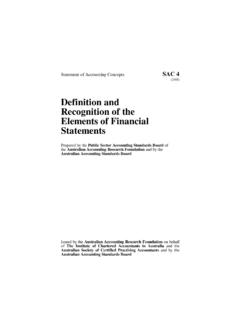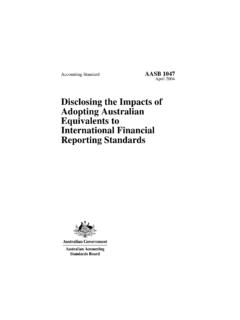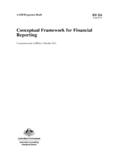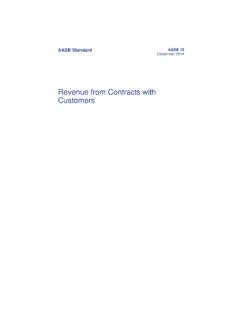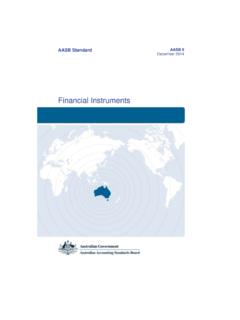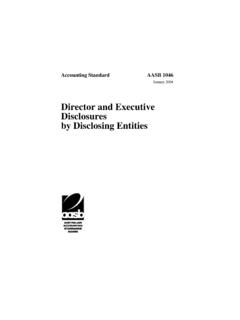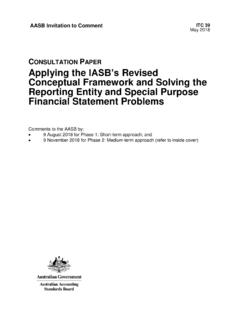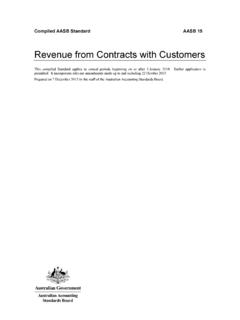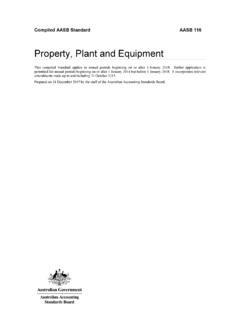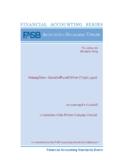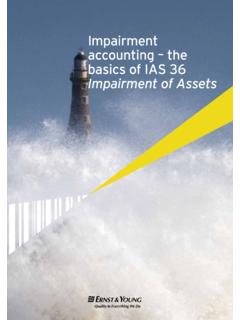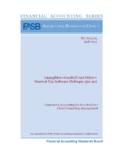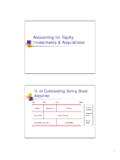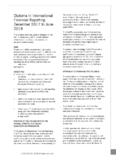Transcription of Accounting for Goodwill - aasb.gov.au
1 Accounting StandardAASB 1013 June 1996 Accounting for GoodwillIssued by theAustralian Accounting Standards BoardAASB 10132 Obtaining a Copy of this Accounting StandardCopies of this Standard are available for purchase from the AustralianAccounting Standards Board by contacting the Australian AccountingResearch Foundation as follows:The Customer Service OfficerAustralian Accounting Research Foundation211 Hawthorn RoadCaulfield Victoria 3162 AUSTRALIAP hone:(03) 9523 8111 Fax:(03) 9523 1996 Australian Accounting Standards Board. The copying of thisStandard is only permitted in certain circumstances. Enquiries should bedirected to the Australian Accounting Standards 1036-4803 AASB 10133 CONTENTSMAIN FEATURES OF THE STANDARD .. page 5 Section and page number1 Application.
2 62 Operative Date .. 63 Purpose of Standard .. 74 Internally Generated Goodwill .. 75 Purchased Goodwill .. 7 Accounting Treatment for PurchasedGoodwill .. 7 Measurement of Purchased Goodwill .. 106 Subsequent Changes in Cost ofAcquisition .. 117 Subsequent Identification of Assets andLiabilities .. 128 Discount on Acquisition .. 139 Treatment of Goodwill or Discount onAcquisition of a Subsidiary .. 1410 Disclosures .. 1411 Comparative Information .. 1412 Transitional Provisions .. 15 Application of the Straight-Line Method .. 15 Superseded Standard Applied to Entity .. 15 Superseded Standard Did Not Applyto Entity .. 1613 Definitions .. 16 AASB 10134 CONFORMITY WITH INTERNATIONAL AND NEWZEALAND Accounting STANDARDS .. page 19 Defined words appear in italics the first time they appear in asection.
3 The definitions are in Section 13. Standards are printedin bold type and commentary in light 10135 MAIN FEATURES OF THE STANDARDThe Standard prescribes the Accounting treatment for Goodwill and discounton acquisition arising on acquisition of a business entity, or part thereof,through acquisition of the assets, or in the case of an investment in asubsidiary or in an associated company, through the acquisition of some orall of the shares in another entity. The Standard also prescribes theaccounting treatment for internally generated main revision to the superseded Accounting Standard AASB 1013" Accounting for Goodwill " is that the straight-line method of amortisationhas been Standard has been presented in plain English format, consistent withthe approach adopted in recent standards and exposure drafts issued by theBoard.
4 However, aside from amendments to effect the revision outlinedabove, the requirements of the Standard remain the same as those of thesuperseded 10136 STANDARDAASB 1013 " Accounting FOR Goodwill " to paragraph , this Standard applies to each entitywhich is required to prepare financial statements in accordancewith Part of the Corporations Law and which:(a)is a reporting entity; or(b)holds those financial statements out to be, or form partof, a general purpose financial a requirement of this Standard is inconsistent with anyprovision of the Corporations Law or the CorporationsRegulations, the requirement does not standards specified in this Standard apply to the financialreport where information resulting from their application ismaterial, in accordance with Accounting Standard AASB 1031"Materiality".
5 2 Operative Standard applies to financial years ending on or after 30 June Standard may be applied to financial years ending before30 June 1996 where an election has been made in accordancewith subsection 285(3) of the Corporations operative, this Standard supersedes Accounting StandardAASB 1013 " Accounting for Goodwill " as approved by noticepublished in Gazette No. S 110 on 18 April 1988 and amendedby Accounting Standard AASB 1025 "Application of theReporting Entity Concept and Other Amendments".AASB 10137 of this Standard was published in the Commonwealth ofAustralia Gazette on 14 June 10138 of purpose of this Standard is to:(a)specify the manner of Accounting for Goodwill anddiscount on acquisition on the acquisition of an entity, orpart thereof; and(b)require disclosure of information relating to Goodwill sothat users of financial reports are provided withinformation about the financial position andperformance of the Generated which is internally generated by the entity must not berecognised by that which is internally generated by an entity is not permittedby this Standard to be recognised as an asset by that entity.
6 This isprincipally because of the difficulty, or impossibility, of identifyingthe events or transactions which contribute to the overall goodwillof the entity. Even if these were identifiable, the extent to whichthey generate future benefits and the value of such benefits are notusually capable of being measured reliably. Internally generatedgoodwill which is not recognised as an asset will either gocompletely unrecognised or will be recognised as an GoodwillAccounting Treatment for Purchased which is purchased by the entity must be recognised asa non-current asset at with the definition of assets as service potential or futureeconomic benefits controlled by the entity as a result of pasttransactions or other past events, this Standard specifies thatgoodwill is an asset.
7 In particular, Goodwill comprises the futurebenefits from unidentifiable assets which, because of their nature,AASB 10139 not normally individually recognised. Examples ofunidentifiable assets include market penetration, effectiveadvertising, good labour relations and a superior operating assets do not include assets of an intangible naturewhich are capable of being both individually identified andseparately recognised, as may be the case with patents, licences,rights and distinction is frequently drawn between Goodwill which ispurchased and Goodwill which is internally generated. ThisStandard specifies that the concept of Goodwill as an asset is thesame regardless of whether it has been purchased in an exchangetransaction or generated internally. However, purchased goodwillcan be measured more reliably, on the basis of the amount paid forit, than can internally generated Goodwill which is not usuallycapable of being measured reliably.
8 Consequently, the accountingtreatment for purchased Goodwill differs from that specified forinternally generated is recognised as an asset only when it satisfies thefollowing asset recognition criteria:(a)it is probable that the future benefits embodied in theunidentifiable assets will eventuate; and(b)it possesses a cost or other value that can be will be the case only when Goodwill is purchased in connectionwith the acquisition of an entity, or part thereof, through acquisitionof the assets therein or, in the case of an investment in a subsidiary,the acquisition of some or all of the shares in another entity. Suchpurchased Goodwill reflects: future benefits which are internallygenerated by the vendor prior to the date of acquisition and areexpected to flow to the purchaser.
9 And future benefits which arisefrom the combination or inter-relationship of entities or groups Goodwill must be amortised so that it is recognised asan expense in the profit and loss account on a straight-line basis,over the period from the date of acquisition to the end of theperiod of time during which the benefits are expected to 101310 period must not exceed twenty years from the date 101311 accordance with paragraph , the unamortised balance ofgoodwill must be reviewed as at each reporting date and recognisedin the profit and loss account as an expense to the extent that futurebenefits are no longer order to amortise Goodwill over the period during which theassociated benefits are expected to arise, separate assessments mayneed to be made in respect of different Goodwill components (suchas those relating to the purchase of different businesses) to theextent that such components can be separately which are to be considered in estimating the useful lives ofthe assets comprising Goodwill include:(a)effects of obsolescence, demand and other economicfactors; and(b)the service life expectancies of individual employees orgroups of employees; and(c)expected actions by competitors or potential competitors;and(d)relevant legal, regulatory or contractual provisions; and(e)foreseeable life of the entity or the period of anticipated benefits will in manycircumstances be difficult to identify, decisions concerning theperiod of amortisation may be arbitrary.
10 In some circumstances theperiod of amortisation may be short, but in no circumstance doesthis Standard permit the amortisation period to exceed twenty yearsfrom the date of to paragraph , the period over which Goodwill is tobe amortised must be reviewed as at each reporting date and, ifnecessary, adjusted to reflect the amount and timing of expectedfuture benefits. The period must not extend beyond twentyyears from the date of 101312 unamortised balance of Goodwill must be reviewed at eachreporting date and recognised as an expense in the profit andloss account to the extent that future benefits are no than required by paragraph , purchased goodwillmust not be of Purchased acquisition of an entity, or part thereof, through acquisitionof the assets therein or, in the case of an investment in asubsidiary, on acquisition of some or all of the shares of anotherentity, the identifiable net assets of the entity (acquired directlyor indirectly) must be measured at their fair determining the amount of purchased Goodwill the purchaserneeds to recognise all assets acquired, whether of a tangible orintangible nature.
